200 yard Ballistic Coefficient test data. Changes with range
Posted: Sun Feb 14, 2010 5:09 pm
This testing was done last weekend in The Snowy Mountains. I want to share it with you as I think it would be a first in air rifle data collection at this range and the results, if supported by further testing, are interesting and probably counter-intuitive. I hasten to write they are specifically related to the very dynamically stable pellets as used in this rifle, and though it is quite possible other pellets behave similarly, there will be many that probably do not.
The purpose of this study was to collect data at three different ranges 50, 100 and 200 yards under consistent ambient conditions for the derivation of the respective BCs for input into the Chairgun ballistic programme . It was intended to then compare the results in order to perhaps find out more about BC changes with range or perhaps time of flight TOF and or velocity.
Rifle BSA .25 cal Hornet prepared by John Bowkett; pellets the new 0.25 cal JSB 25.4 gr Kings. This combination is known for consistency having shot a 25 shot string with just 6 fps extreme spread; and for accuracy having shot 0.573 MOA at 100 yards and very close to MOA it at 202 yards (1.08 MOA / 2.30 inches ).
Temperature 23 C or 73.4 F
Altitude was 4,035 ft or 1230 m. (The BCs below have also been corrected for “sea level” NTP for others to relate to. … Very good conditions for the most part ( nothing is ever perfect).
One chronograph was used with steel angle iron protection. It was moved from 1.5 ft to 200 yards, to 100 yards, to 50 yards for the tests. Range was established with a Bushnell range finder. As I could not see the chronograph, or read it if I could, a spotter was required. See pics below.
Minimum time was wasted in barrowing the equipment to set up between ranges. The sky was overcast throughout and the light was even thus making for good chronograph functioning.
The chronograph had a fresh battery. The rifle was kept charged well above the regulator set pressure.
RESULTS:
889.9 fps at 1.50 ft; ( 888, 891, 890, 889, 892 rounded) therefore MV 891.5; ME 44.84
Retained velocity at 50 yards:
762.0
760.2
760.0
764.3
763.1
Average 761.9; fpe 32.74. BC 0.0398 or 0.0337 corrected for NTP.
Retained velocity at 100 yards ( rounded ):
662
669
663
668
670
Average 666.4; fpe 25.05. BC 0.0430 corrected 0.0364
Retained velocity at 200 yards:
511
510
514.8
Average 511.9; fpe 14.79. BC 0.0451 corrected 0.0382
Only three successful shots passed over the chronograph's sensors at 200 yards before the soft breeze made shooting for this purpose impracticable at that range, but the three are very close together. .
Using Steve Woodward’s calculator this gives BCs as follows:
0 to 50 yards : 0.0398 or corrected to NTP 0.0337
0 to 100 yards: 0.0430 or corrected 0.0364.
0 to 200 yards: 0.0451 or corrected 0.0382.
And:
50 to 100 yards: 0.0467 or corrected 0.0395.
50 to 200 yards: 0.0471 or corrected 0.0399.
100 to 200 yards: 0.0474 or corrected 0.0401.
I am thinking that the progressive improvement in BC from 0.0337 average to 50 yards to 0.0382 average to 200 yards, as the pellet moves down range, may be a direct reflection of the progressive damping out of precession / nutation ( albeit of minute magnitude in these very dynamically stable pellets ).
The pellets may require as much as 0.40+ seconds, or 100+ yards, to achieve this damping. When one considers the time taken by a spinning top to settle, then at least 0.4 seconds may seem appropriate for a pellet. It is interesting to note that the .50 cal BMG round has been shown by Doppler to improve its BC out to 800 yards then decay again after 1300 yards or so. This may be happening here scaled back to air rifle ranges.
The implications, of this data, point to the further refining of range tables for long range shooting. For example if the average BC from muzzle to 200 yards is 0.0382 at sea level, that should be used rather than the 0 yard to 50 yard figure of 0.0337 in this instance. I have had other data to suggest this can be extrapolated back to closer ranges. In “normal” air rifle shooting to 40 or 50 yards a ballpark BC figure is close enough to use but as the range stretches out things seem to change.
I must point out that all pellets are not equal and as you all know, all rifles do not shoot them the same. Some pellets are definitely dynamically unstable and would not profile their BC like these JSB King .25s do. One glaring example is the Beeman Crow Magnum which is very dynamically unstable ( great for whacking things at close range as it gyrates at about 45 degrees and more. ... So each pellet would have to be tested to see its particular characteristics. … My interest is in long and extreme range precision shooting, thus I have no use for pellets that will not perform to sub MOA out to extreme range in excellent conditions.
Pictures:
The Moffitt Farm Range with Rob Moffitt way down there at the 200 yard target on the flat through the tree gap waiting to spot. He stands beside his formwork board screen with the target stand to his left.
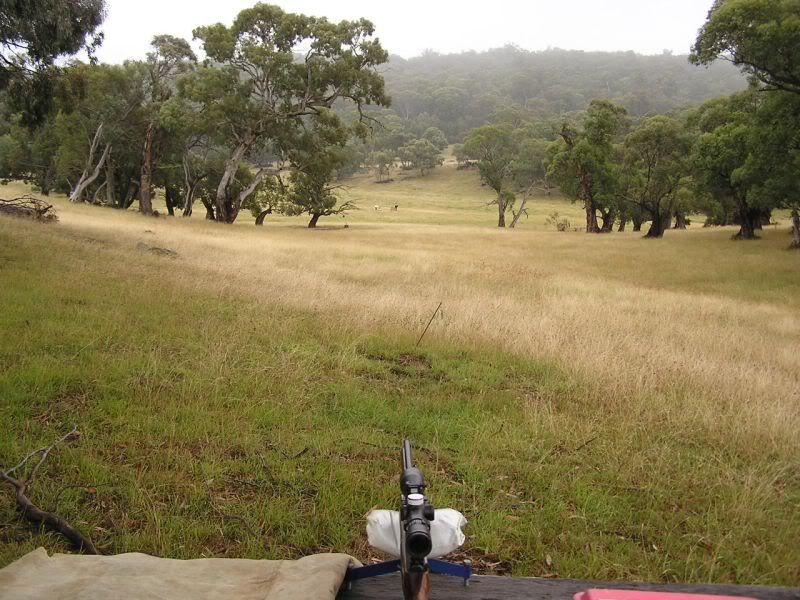
Close up showing the Chronograph hidden behind the steel angle iron; a 100 L oil drum and paint tin used to show evidence of the 14+ fpe remaining pellet KE at 200 yards; and Rob with his barrow and form work protection shield.
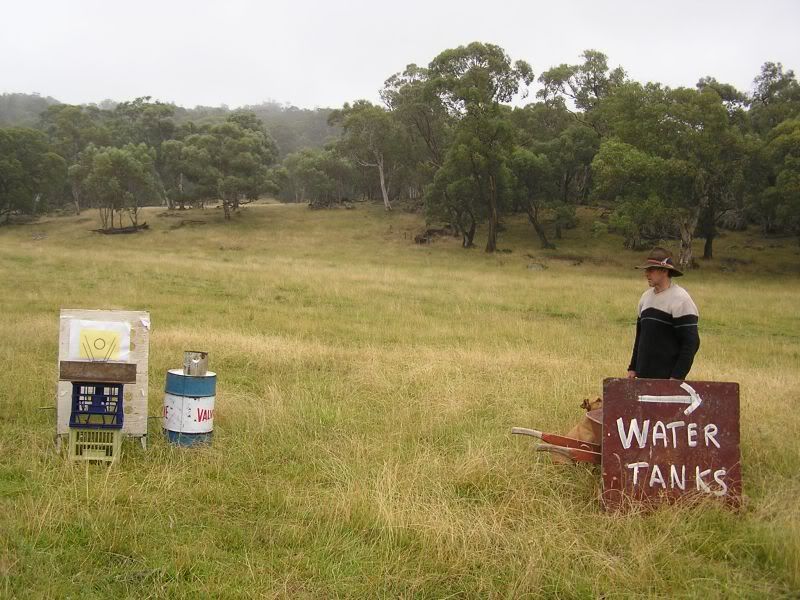
The paint tin showing POI entry and exit ( 200 yards ) of the initial ranging shot and the result of near 15 fpe measured at 200 yards.
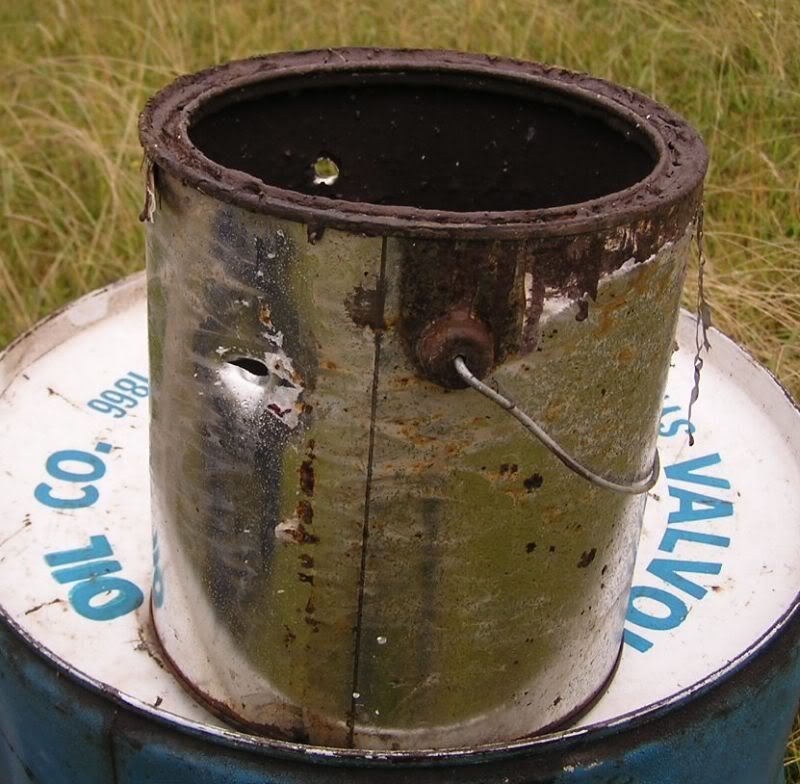
Likewise three serious dents in the 100 litre oil drum from the JSB Kings at 200 yards from the next three ranging shots. You will have noted that the 25.4 gr Kings had 512 fps retained for 14.79 fpe at 200 yards:
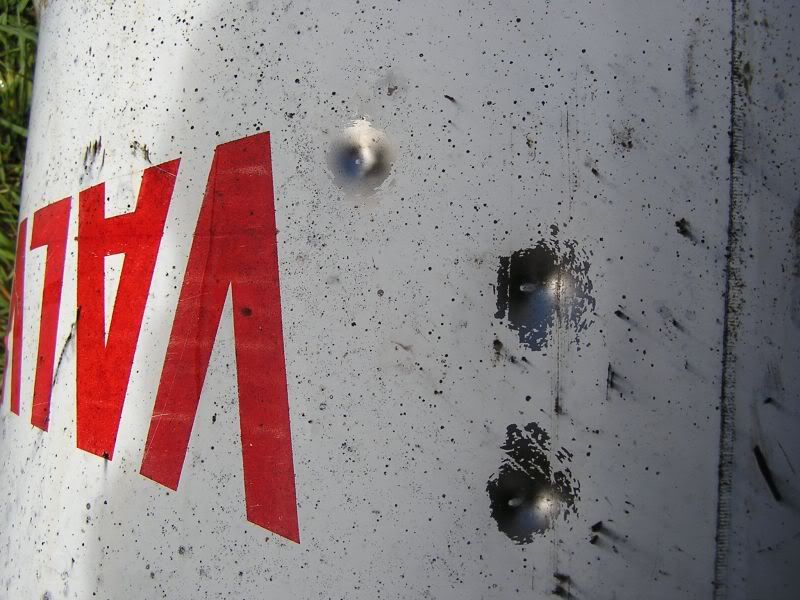
100 yard target showing the narrow band (lines drawn after ) between which the pellets had to pass in order to "ring the bell" Those to right or left did not register on the chronograph. I was aiming off laterally shot to shot to beat the light breeze 3 o’clock breeze ( which obviously beat me for those two to the left and over compensation for the nice little group to the right of centre ):
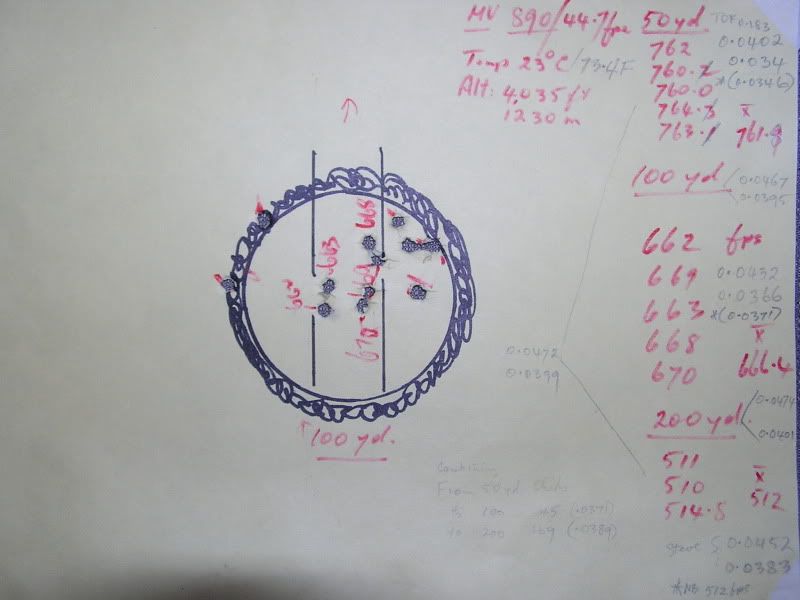
It is not easy to get data at these ranges and the more complex the experimental design, the more time in logistics, therefore the more chance of conditions changing. This was the best I could do on the day and the mountain weather was very kind and as good as it gets for such a session.
It is an 11 hour round trip from home to this location.
I hope some have read this far and of course it is open for comments.
Kind regards, Harry in OZ.
The purpose of this study was to collect data at three different ranges 50, 100 and 200 yards under consistent ambient conditions for the derivation of the respective BCs for input into the Chairgun ballistic programme . It was intended to then compare the results in order to perhaps find out more about BC changes with range or perhaps time of flight TOF and or velocity.
Rifle BSA .25 cal Hornet prepared by John Bowkett; pellets the new 0.25 cal JSB 25.4 gr Kings. This combination is known for consistency having shot a 25 shot string with just 6 fps extreme spread; and for accuracy having shot 0.573 MOA at 100 yards and very close to MOA it at 202 yards (1.08 MOA / 2.30 inches ).
Temperature 23 C or 73.4 F
Altitude was 4,035 ft or 1230 m. (The BCs below have also been corrected for “sea level” NTP for others to relate to. … Very good conditions for the most part ( nothing is ever perfect).
One chronograph was used with steel angle iron protection. It was moved from 1.5 ft to 200 yards, to 100 yards, to 50 yards for the tests. Range was established with a Bushnell range finder. As I could not see the chronograph, or read it if I could, a spotter was required. See pics below.
Minimum time was wasted in barrowing the equipment to set up between ranges. The sky was overcast throughout and the light was even thus making for good chronograph functioning.
The chronograph had a fresh battery. The rifle was kept charged well above the regulator set pressure.
RESULTS:
889.9 fps at 1.50 ft; ( 888, 891, 890, 889, 892 rounded) therefore MV 891.5; ME 44.84
Retained velocity at 50 yards:
762.0
760.2
760.0
764.3
763.1
Average 761.9; fpe 32.74. BC 0.0398 or 0.0337 corrected for NTP.
Retained velocity at 100 yards ( rounded ):
662
669
663
668
670
Average 666.4; fpe 25.05. BC 0.0430 corrected 0.0364
Retained velocity at 200 yards:
511
510
514.8
Average 511.9; fpe 14.79. BC 0.0451 corrected 0.0382
Only three successful shots passed over the chronograph's sensors at 200 yards before the soft breeze made shooting for this purpose impracticable at that range, but the three are very close together. .
Using Steve Woodward’s calculator this gives BCs as follows:
0 to 50 yards : 0.0398 or corrected to NTP 0.0337
0 to 100 yards: 0.0430 or corrected 0.0364.
0 to 200 yards: 0.0451 or corrected 0.0382.
And:
50 to 100 yards: 0.0467 or corrected 0.0395.
50 to 200 yards: 0.0471 or corrected 0.0399.
100 to 200 yards: 0.0474 or corrected 0.0401.
I am thinking that the progressive improvement in BC from 0.0337 average to 50 yards to 0.0382 average to 200 yards, as the pellet moves down range, may be a direct reflection of the progressive damping out of precession / nutation ( albeit of minute magnitude in these very dynamically stable pellets ).
The pellets may require as much as 0.40+ seconds, or 100+ yards, to achieve this damping. When one considers the time taken by a spinning top to settle, then at least 0.4 seconds may seem appropriate for a pellet. It is interesting to note that the .50 cal BMG round has been shown by Doppler to improve its BC out to 800 yards then decay again after 1300 yards or so. This may be happening here scaled back to air rifle ranges.
The implications, of this data, point to the further refining of range tables for long range shooting. For example if the average BC from muzzle to 200 yards is 0.0382 at sea level, that should be used rather than the 0 yard to 50 yard figure of 0.0337 in this instance. I have had other data to suggest this can be extrapolated back to closer ranges. In “normal” air rifle shooting to 40 or 50 yards a ballpark BC figure is close enough to use but as the range stretches out things seem to change.
I must point out that all pellets are not equal and as you all know, all rifles do not shoot them the same. Some pellets are definitely dynamically unstable and would not profile their BC like these JSB King .25s do. One glaring example is the Beeman Crow Magnum which is very dynamically unstable ( great for whacking things at close range as it gyrates at about 45 degrees and more. ... So each pellet would have to be tested to see its particular characteristics. … My interest is in long and extreme range precision shooting, thus I have no use for pellets that will not perform to sub MOA out to extreme range in excellent conditions.
Pictures:
The Moffitt Farm Range with Rob Moffitt way down there at the 200 yard target on the flat through the tree gap waiting to spot. He stands beside his formwork board screen with the target stand to his left.

Close up showing the Chronograph hidden behind the steel angle iron; a 100 L oil drum and paint tin used to show evidence of the 14+ fpe remaining pellet KE at 200 yards; and Rob with his barrow and form work protection shield.

The paint tin showing POI entry and exit ( 200 yards ) of the initial ranging shot and the result of near 15 fpe measured at 200 yards.

Likewise three serious dents in the 100 litre oil drum from the JSB Kings at 200 yards from the next three ranging shots. You will have noted that the 25.4 gr Kings had 512 fps retained for 14.79 fpe at 200 yards:

100 yard target showing the narrow band (lines drawn after ) between which the pellets had to pass in order to "ring the bell" Those to right or left did not register on the chronograph. I was aiming off laterally shot to shot to beat the light breeze 3 o’clock breeze ( which obviously beat me for those two to the left and over compensation for the nice little group to the right of centre ):

It is not easy to get data at these ranges and the more complex the experimental design, the more time in logistics, therefore the more chance of conditions changing. This was the best I could do on the day and the mountain weather was very kind and as good as it gets for such a session.
It is an 11 hour round trip from home to this location.
I hope some have read this far and of course it is open for comments.
Kind regards, Harry in OZ.
